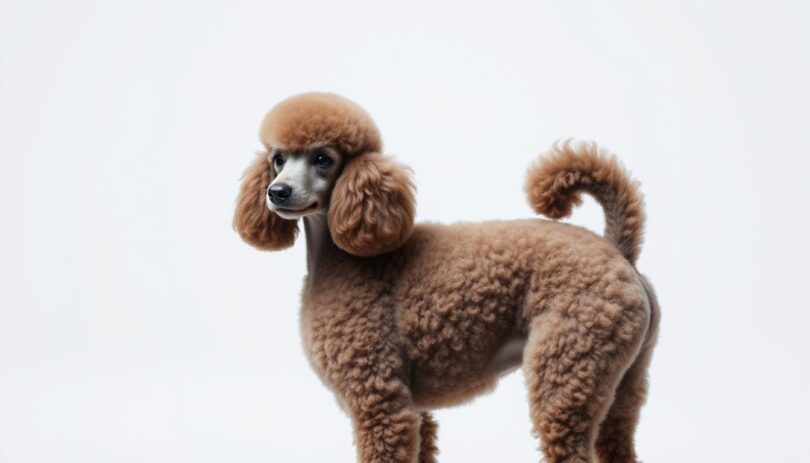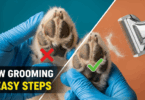What if your dog’s haircut could boost both their health and style? While many assume grooming is purely about aesthetics, the truth runs deeper. For this curly-coated breed, regular trims aren’t just fashionable—they’re essential for maintaining skin health and preventing tangles.
Unlike breeds that shed, these dogs rely on consistent care to keep their unique coats in top shape. Without proper attention, mats can form, leading to discomfort or even skin infections. Professional groomers recommend brushing every few days and scheduling trims every 4–6 weeks.
Today’s trending styles blend practicality with creativity. The Teddy Bear trim offers a playful, fluffy look, while the Continental style delivers timeless elegance. Low-maintenance options like the Puppy Cut prioritize comfort, making them ideal for active pets.
Choosing the right style depends on your dog’s lifestyle and your personal taste. Whether you prefer sleek lines or whimsical shapes, each design serves a purpose beyond looks. Ready to explore how the perfect trim can elevate your companion’s well-being and turn heads at the park?
Introduction to Poodle Grooming Trends
Canine fashion has come a long way since the 15th century. What began as protective clipping for hunters evolved into expressive styles that charm dog lovers worldwide. Today’s groomers balance historical techniques with modern creativity to craft looks that prioritize both form and function.
The Evolution of Poodle Styles
Originally bred as water retrievers, these dogs sported practical trims. Thick fur around joints protected them from cold waters while shorter areas improved swimming. By the 18th century, grooming became an art form among European nobility.
The 20th century brought radical changes. Show rings popularized sculpted patterns, while pet owners sought easier maintenance. This shift birthed enduring favorites like the teddy bear cut, blending playfulness with manageable care.
Why Current Trends Matter
Modern styles influence more than aesthetics. The teddy bear trim’s rounded face requires monthly shaping but reduces eye irritation. Popular puppy-inspired looks keep coats shorter for active families while maintaining that signature fluffy charm.
Understanding these trends helps owners choose styles that match their lifestyle. Fashion-forward grooming isn’t just about looks—it shapes brushing routines, vet visits, and your dog’s comfort in different seasons.
Understanding Your Poodle’s Coat and Care Needs
A poodle’s coat isn’t just about looks—it’s a marvel of biological engineering. Unlike most breeds, their hair grows continuously without shedding, forming tight curls that demand attentive care. This unique texture traps dirt and moisture, making regular brushing non-negotiable for preventing painful mats.
Daily sessions with a slicker brush keep the body’s hair tangle-free. Focus on high-friction areas like behind the ears and under the legs. For curly coats, use a detangling spray to glide through knots gently. Corded varieties require specialized techniques, like separating strands by hand to maintain their rope-like appearance.
Texture plays a starring role in styling choices. Tight curls hold sculpted shapes well but need trimming every 4–6 weeks. Softer waves might allow longer styles but require more frequent brushing. Always check the skin during grooming—dry patches or redness signal it’s time to adjust your routine.
Healthy coats feel smooth and springy to the touch. If sections clump or resist combing, it’s a warning sign. Professional groomers recommend using a stainless-steel comb monthly to test for hidden mats. With proper care, your companion’s fur becomes a canvas for creativity and a badge of well-being.
Low-Maintenance Grooming for Busy Poodle Owners
Balancing a busy schedule with pet care doesn’t have to mean compromising on your dog’s appearance. Practical grooming styles offer smart solutions for modern lifestyles while keeping coats healthy. These designs prioritize both convenience and comfort through strategic trimming techniques.
Benefits of Easy-Trim Styles
Simplified trims like the kennel cut maintain a uniform length across the body. This approach slashes brushing time by 60% compared to layered styles. Shorter coats also dry faster after baths or rainy walks, reducing skin irritation risks.
Active dogs benefit from trimmed legs and rounded paws that prevent debris buildup. The puppy-inspired look keeps facial fur short to avoid eye gunk while preserving that youthful charm. Regular maintenance every 6-8 weeks helps avoid matting without daily detangling sessions.
When to Opt for Simplicity
Choose streamlined styles if weekly brushing feels overwhelming. Busy professionals or families with young children often prefer these hassle-free options. Short body trims work well for dogs who swim frequently or play in wooded areas.
Consider your pet’s age too. Senior dogs appreciate shorter coats that ease joint movement. Always consult your groomer about length preferences – they can adjust standard designs to suit your routine while keeping your companion camera-ready.
The Classic Puppy Cut and Teddy Bear Look
Two iconic styles dominate the world of canine grooming for curly-coated companions. The puppy cut delivers timeless simplicity, while the bear cut adds playful charm through strategic shaping. Both approaches prioritize comfort but cater to different preferences in aesthetics and upkeep.
Key Features That Define the Style
The puppy cut maintains a uniform 1-2 inch length across the body, legs, and face. This no-fuss approach minimizes brushing sessions and prevents debris from clinging to shorter fur. Active dogs stay cooler during summer adventures thanks to increased airflow near the skin.
Bear cut enthusiasts opt for slightly longer facial hair that frames the eyes like fluffy earmuffs. Groomers leave the muzzle area about half an inch longer than the body, creating that signature cuddly appearance. Regular trims every 6 weeks keep this look photogenic without matting challenges.
While both styles require monthly maintenance, the puppy cut edges out its counterpart in ease of care. The bear cut’s charming face details demand precise scissor work during grooming appointments. For owners seeking compromise, some professionals blend both techniques—keeping body hair short while allowing slightly longer cheek tufts.
Always discuss your dog’s daily routine with your groomer. They might suggest shortening the puppy cut’s length for swimming enthusiasts or adjusting the bear cut’s facial proportions for pets prone to eye irritation. With proper planning, these classic styles deliver both practicality and personality.
Modern Twist: Combining Short Body with Longer Hair
Grooming enthusiasts are redefining canine style with bold contrasts that serve both form and function. The latest trend pairs a neatly trimmed torso with strategic longer hair accents, creating eye-catching silhouettes while simplifying daily care.
Achieving the cut perfect balance requires artistic precision. Skilled groomers leave the rest body kept short for easy maintenance, then sculpt flowing manes around the head, legs, or tail. The Continental style exemplifies this approach with pom-poms on joints and hips that nod to historical designs.
This hybrid technique shines in practical scenarios. Active dogs benefit from reduced matting in high-movement areas while retaining signature flair. The Miami variation keeps facial fur and ears flowing for visual drama but trims the torso close—ideal for warm climates or water-loving companions.
For those exploring hybrid breeds through poodle mixes, these styles adapt beautifully to various coat textures. Regular brushing with tools like slicker brushes maintains the longer hair sections without overwhelming owners. Most designs need professional touch-ups every 6-8 weeks to preserve crisp lines.
The trend’s popularity stems from its dual-purpose appeal. Owners gain manageable grooming routines while their pets showcase runway-ready looks. Whether opting for a lamb-inspired leg fluff or dramatic Mohawk stripe, this modern approach proves practicality and panache aren’t mutually exclusive.
Expert Grooming Tips for a Fluffy, Healthy Coat
Achieving that cloud-like fluff requires more than wishful thinking—it demands technique. Professional groomers emphasize daily care routines that protect hair texture while enhancing natural volume. Start by choosing tools matched to your dog’s specific needs: rubber brushes lift dead hair, while slicker versions tackle curls without tugging.
Essential Brushing Techniques
Brush in sections using short strokes that follow hair growth patterns. Always begin at the skin level to prevent hidden mats. For stubborn tangles, mist detangling spray and work from the tips upward. Finish with a metal comb to verify no knots remain—this step ensures coats stay smooth between grooming sessions.
Focus on facial fur to amplify expressive eyes. Trim around the muzzle weekly using curved scissors for safety. Many groomers recommend professional shaping every 6 weeks to maintain symmetry. At home, wipe the face daily with a damp cloth to prevent crusty buildup.
Know when to call experts. If brushing takes longer than 15 minutes or causes discomfort, schedule a groomer visit. They’ll address matting issues safely and recommend personalized tools. Regular appointments every 4-6 weeks keep coats manageable while preserving that signature bounce.
Innovative poodle cuts for a Tail-Wagging Transformation
What if your dog’s trim could become wearable art? Forward-thinking groomers now craft avant-garde designs that turn standard grooming into creative expression. These boundary-pushing styles blend sculptural elements with practical care, transforming four-legged companions into living masterpieces.
Geometric patterns and asymmetrical shapes create dramatic visual impact. One trending design features a checkerboard motif shaved into the torso fur, contrasting with fluffy leg puffs. Such bold choices elevate a dog’s appearance while maintaining coat health through strategic shorter sections.
Proportional leg trimming proves crucial in these modern designs. Longer fur on the lower legs balances shortened body hair, creating optical illusions of athleticism or elegance. Groomers might taper hindquarters to accentuate movement, making every walk look like a runway strut.
The “Urban Edge” style exemplifies functional artistry. It keeps the body closely trimmed for easy care but leaves artistic tufts at the ankles and tail tip. This approach reduces matting risks in high-friction areas while delivering head-turning flair.
These innovative cuts don’t just impress at the park—they boost canine confidence. Dogs with striking styles often receive more positive attention, encouraging socialization. With proper planning, even the most daring designs can simplify maintenance while making pets feel like superstars.
Sculpting the Bear Cut: From Teddy Bear to Bear Look
Transforming a fluffy coat into a living teddy bear requires more than scissors—it’s an exercise in geometry. Groomers start by establishing the signature round head shape using curved shears, creating symmetrical arcs around the eyes. The body gets trimmed to 1 inch, while legs retain 2 inches of fluff to mimic stuffed animal proportions.
This style elevates traditional teddy trims through dramatic contouring. Cheek tufts extend further than classic designs, framing the face like a plush hood. Expert stylists carve concave curves along the torso to accentuate the illusion of soft, toy-like roundness.
Maintenance demands precision. Weekly brushing with a pin brush preserves the shape’s integrity, focusing on the dense ruff around the neck. Monthly touch-ups address growing facial hair that could obscure the bear-like eye definition. Thinning shears help blend transitions between short and long sections seamlessly.
While the teddy bear look favors uniformity, the modern bear cut embraces artistic asymmetry. One ear might sport slightly longer tufts for playful character. Groomers often leave a heart-shaped patch on the chest as a hidden detail—a nod to the style’s cuddly inspiration.
For perfect symmetry, professionals recommend rotating your companion during home brushing sessions. Always check both profiles in a mirror to spot uneven areas. This attention to shape keeps the bear illusion intact between salon visits, ensuring your furry friend stays camera-ready.
Grooming Tools and Techniques for Flawless Styles
Every masterpiece begins with the right instruments. Professional groomers rely on specialized tools to create polished looks while protecting coat health. Understanding which equipment to use—and how—transforms routine maintenance into an art form.
Must-Have Grooming Tools
Sharp stainless-steel shears deliver clean lines without tugging. Thinning scissors blend transitions between trimmed and untrimmed areas seamlessly. A quality clipper with adjustable guards maintains consistent lengths across the body.
Metal combs detect hidden mats better than plastic versions. Slicker brushes with flexible pins untangle curls gently. For finishing touches, curved shears sculpt rounded paw pads and facial contours.
Technique Tips from the Pros
Always hold shears at a 45-degree angle when shaping ears. Work against the hair growth direction with clippers for even results. Use thinning tools on dense areas like the chest to prevent bulky appearances.
Focus on three key zones: ear bases, paw pads, and tail joints. These spots collect debris and require weekly checks. Professionals recommend blending techniques that mimic natural coat patterns for organic-looking trims.
Consistent tool maintenance matters as much as skill. Clean blades after each session and oil clippers monthly. Sharp tools reduce grooming time by 40% and prevent split ends. Pair these practices with 6-week trimming cycles for coats that stay manageable and camera-ready.
Seasonal Grooming: Keeping Your Poodle Cool in the Summer
Summer’s rising temperatures demand smart grooming strategies for curly-coated companions. Heat impacts these dogs differently than short-haired breeds—their dense fur traps warmth against the skin. Regular trims become essential to prevent overheating while maintaining coat health.
Opt for shorter body lengths during hot months, leaving ½-1 inch of fur for sun protection. Focus on high-heat zones: trim underbelly and inner leg hair to improve airflow. Avoid shaving completely, as exposed skin risks sunburn and loses natural insulation.
Consistent grooming sessions save time by preventing severe matting. Schedule appointments every 4-5 weeks to manage growth efficiently. Use cool blow-dry settings after baths to avoid trapping moisture that causes skin irritation.
Adapt routines as weather shifts. Increase brushing frequency to 4-5 times weekly, removing dead hair that insulates heat. Check paw pads regularly for cracks from hot surfaces—apply pet-safe balm if needed.
Watch for panting or lethargy during heat waves. These signs suggest it’s time for a cool-down session. With proper seasonal care, your furry friend stays comfortable while rocking a practical summer style.
Maintaining a Mat-Free and Healthy Coat
A well-maintained coat acts as both armor and insulation for active dogs. Regular care prevents discomfort while letting their natural beauty shine through. Start by establishing a consistent brushing routine tailored to your companion’s unique fur texture.
Mastering Tangle Prevention
Use a slicker brush daily, working in small sections from skin level outward. For tight curls, spray a dog-safe detangler before brushing. Always follow with a metal comb to catch hidden knots behind ears and under legs.
Moisturizing matters more than owners realize. Bathe every 3-4 weeks using oatmeal-based shampoo, then apply leave-in conditioner. This keeps hair flexible and reduces breakage during brushing. Pat coats dry instead of rubbing to prevent frizz.
Avoid these common mistakes:
– Skipping weekly skin checks for dryness or irritation
– Using human hair products that strip natural oils
– Brushing top layers while ignoring undercoat
– Waiting until mats form before seeking help
For corded coats, separate strands gently with fingers after misting with water. Schedule professional grooming every 5 weeks to maintain shape and health. With proper care, your furry friend’s coat becomes a testament to their well-being.
When to Groom at Home and When to See a Professional
Deciding between DIY care and salon visits depends on your dog’s needs and your schedule. A balanced approach combines regular maintenance with expert touch-ups, ensuring comfort and style without overwhelming busy owners.
Finding the Right Balance
Home grooming works well for weekly brushing and nail trims. Basic tools like slicker brushes and stainless-steel combs help prevent mats between professional visits. Daily care builds bonding time while keeping coats manageable.
Complex styles or severe tangles often require groomer expertise. Professionals handle sensitive areas like ear canals and paw pads safely. They also spot early signs of skin issues owners might miss.
Consider these factors when making your choice:
– Coat texture: Curly hair needs more frequent attention
– Temperament: Anxious dogs may need calm salon environments
– Time constraints: Busy households benefit from hybrid routines
Monthly professional trims paired with home brushing create an ideal balance. This strategy maintains coat health while accommodating modern lifestyles. Always consult your groomer about customized schedules matching your dog’s unique requirements.
Historical Insights into Poodle Grooming Styles
Centuries before dog shows existed, grooming served as survival gear for working canines. Early styles prioritized protection over polish, with thick fur left around joints and vital organs. Hunters in 15th-century Germany shaped these practical designs to shield dogs from icy waters during retrieves.
From Function to Fashion
The iconic pom-pom patterns began as insulation for cold-water tasks. Longer hair around the chest warmed lungs, while shaved hindquarters improved swimming speed. As these dogs transitioned from hunters to royal companions, French nobility transformed utilitarian styles into status symbols.
By the 1800s, grooming became competitive artistry. Elaborate patterns mirrored human hairstyles of the era—Victorian-era puffs echoed hoop skirts, while Baroque curls imitated powdered wigs. Dog shows later standardized these looks, turning survival techniques into show-ring spectacles.
Modern styles still echo historical roots. The Continental cut preserves joint-protecting puffs from its working origins. Current trends like decorative leg bracelets update 18th-century leg warmers used for thorn protection. Each evolution reflects societal values, blending practicality with creative expression.
Understanding this heritage helps owners appreciate today’s options. What began as life-saving insulation now offers endless ways to celebrate canine individuality through thoughtful styling choices.
Styling Your Poodle’s Face, Ears, and Tail for Maximum Cuteness
Accentuating a dog’s best features starts with strategic grooming techniques. Focused attention on expressive areas creates harmony between practicality and charm. These simple methods enhance natural appeal while keeping maintenance manageable.
Simple Steps for a Defined Look
Begin with clean, dry fur to ensure precise trimming. Use curved scissors around the muzzle, moving in small arcs to create a rounded shape. Keep cheek hair slightly longer than the nose area for a balanced facial frame.
For ears, trim edges with thinning shears to soften lines. Leave enough length to highlight their natural fold but avoid covering the ear canal. Weekly cleaning prevents wax buildup and infections.
The tail acts as a visual exclamation point. Trim the base short for cleanliness, leaving a fluffy pom-pom at the tip. Brush upward before cutting to maintain even volume. Avoid blunt cuts—taper the ends for movement.
Common mistakes include over-trimming near eyes and uneven ear shaping. Always check symmetry from multiple angles. Use a detangling spray before brushing sensitive areas like the head and tail base.
Regular touch-ups every 3-4 weeks keep these features camera-ready. Pair professional shaping with at-home brushing to preserve definition. The result? A companion whose every wag and tilt becomes irresistibly photogenic.
Creative Trends: From Cupcake Cuts to Unique Corded Styles
Grooming scissors have become paintbrushes in the hands of modern stylists. Today’s most inventive designs transform standard trims into personalized statements, blending artistry with canine comfort. These boundary-pushing styles celebrate individuality while maintaining coat health through strategic techniques.
Exploring Out-of-the-Box Ideas
The Cupcake Cut exemplifies this creative shift. Stylists sculpt body fur into layered tiers resembling pastry swirls, leaving longer accents on the legs for visual balance. This whimsical design requires meticulous blending to prevent matting while showcasing a dog’s playful personality.
Personality-driven grooming goes beyond aesthetics. Energetic companions might sport geometric patterns that mirror their zest for life, while calm dogs could rock flowing corded styles evoking regal elegance. Top groomers recommend discussing your pet’s habits and quirks during consultations to craft truly personalized looks.
Maintaining these artistic styles demands precision. Weekly brushing sessions preserve intricate details, while professional touch-ups every 5-6 weeks keep edges crisp. The top challenge lies in balancing bold designs with practical care—every flamboyant tuft must serve a functional purpose.
Experimentation thrives when safety comes first. Always prioritize skin protection and mobility when trying avant-garde concepts. With thoughtful planning, you can showcase your companion’s unique personality through grooming that turns walks into gallery exhibitions.
Final Reflections on Poodle Grooming Trends
Grooming transforms routine care into creative expression for devoted pet owners. Today’s styles honor centuries of tradition while embracing modern practicality—from joint-protecting trims to bold geometric patterns. The Modified Continental cut exemplifies this balance, blending historical insulation techniques with sleek contemporary lines.
Trends reveal how pet care evolves alongside lifestyle needs. Busy households lean toward low-maintenance designs like uniform kennel trims, while fashion-forward owners experiment with sculpted accents. What remains constant? Every style serves a purpose beyond aesthetics, whether preventing mats or enhancing mobility.
The best approach celebrates your companion’s personality. Schedule regular trims to maintain coat health, and consult groomers about adapting classic looks. Maybe your pet thrives with playful teddy bear tufts, or perhaps athletic Miami trims suit their active way of life.
As grooming innovations continue, one truth endures: understanding your pet’s needs creates the foundation for timeless style. Whether honoring heritage designs or testing avant-garde concepts, let their comfort guide the way. After all, a happy dog wearing their perfect trim is the ultimate trend.
FAQ
What’s the difference between a teddy bear cut and a puppy trim?
The teddy bear style maintains rounded facial features with slightly longer hair for a plush appearance, while the puppy trim keeps hair uniformly short across the body for minimal upkeep. Both prioritize comfort but cater to different aesthetic preferences.
How often should I brush my dog’s coat to prevent matting?
Brushing 3–4 times weekly with a slicker brush helps avoid tangles, especially in areas prone to friction like behind the ears. For curly or dense coats, daily sessions may be needed during seasonal shedding periods.
Can I maintain a summer-friendly style at home?
Yes! Trimming the body hair short while leaving strategic areas like the ears or tail fuller can keep your pet cool. Use clippers with safety guards and always check for skin sensitivity before cutting.










Leave a Comment